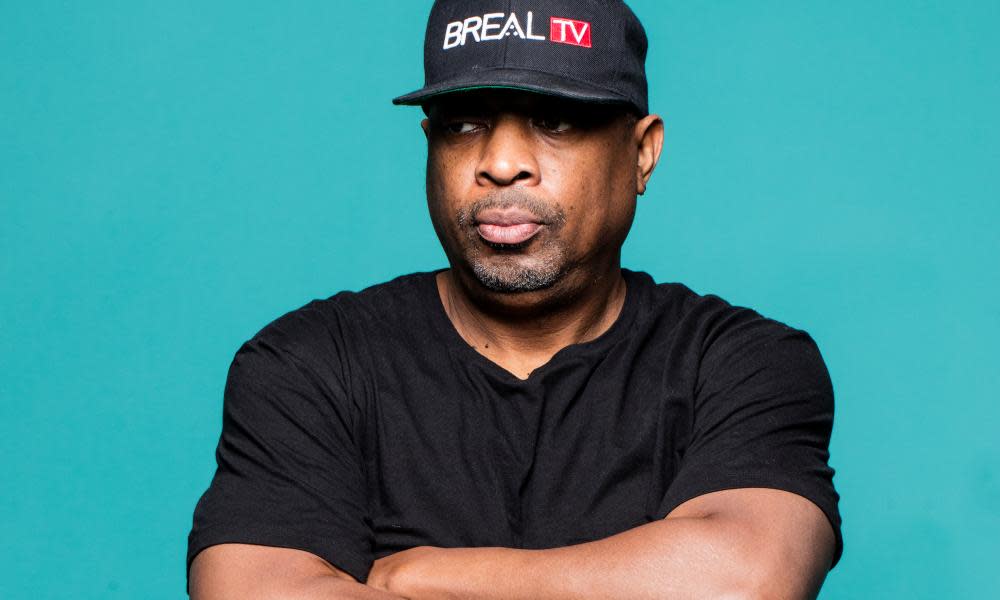‘It’s a sickness’: Chuck D on his new graphic novel and the ‘madness’ of US gun culture

They were the rabble-rousing rappers that brought the 1980s racially charged streets of New York to the masses and turned hip-hop into a potent political force. Public Enemy’s lyrics were born of the violence of prejudice in America, turbulent anthems such as Fight the Power and Don’t Believe the Hype captured the zeitgeist and planted political hip-hop into the heart of American culture.
Their subsequent catalogue of socially raging songs made them one of the most influential bands of the modern era, and culminated in the prestigious Grammy Lifetime Achievement Award in 2020.
“Vocally there was no group faster, no group louder, no group stronger. Words were our bullets,” says Chuck D, Public Enemy’s undeniably charismatic frontman. When the group first thrust themselves on the scene in the mid-80s, racial violence was flaring in black neighbourhoods, he says,
“But our message was, it’s not about me having a gun it’s about me being a thinker.”
Now aged 63 and still wearing his trademark LA Raiders cap flipped back to front, Chuck D – whose real name is Carlton Ridenhour – has swapped lyrics for drawing. Next month sees the publication of his new graphic novel, or naphic grovel as Chuck calls it (“I’ve always mangled the English language,” he quips).
Summer of Hamn is billed as a depiction of gun violence in America, a collection of Chuck’s graffiti-style drawings and verse – all compiled in what he calls “the madness” of last summer. “Every day there were things that were macabre that didn’t even make the news because people had become immune,” he says.
He turned to illustration because people listen more than ever with their eyes. “A picture is worth 10,000 words nowadays,” he says.
A drawing today can get the type of response that a rap record used to get 35 years ago, he adds, especially if it’s something he’s uploaded to Instagram or Facebook or X.
“It’s the most immediate and effective way of communicating what I think and see,” he says, so compiling a book was a natural progression from his music. Even when he writes songs he writes in pictures, he says.
He sketches at what he calls “courtroom speed” – like a quick-fire artist recording a criminal proceeding when the cameras are banned inside.
“My style is my signature. I might do shading, I might not, I might ink it, I might not. It doesn’t have any rules to it. It’s the opposite of photography, it’s interpretation.”
And he interprets everything, from the raw pain of mass shootings to climate change, to the war in Ukraine to the Black Lives Matter movement.
It’s the “Disunited State of America” he decries in one of the images.
Some themes are depicted in portraits and feature prominent people such as Salman Rushdie, Jay-Z, even the Pope.
Urban backdrops sketched in black and white lines capture an apocalyptic-looking America, from the Bronx in New York to Jackson, Mississippi.
“People are confused and angry,” he says. “Only last week a black woman was shot down because she was shoplifting. She was just shoplifting! And it was the police!” he bawls.
As a rapper, gun violence is the issue that impacts Chuck D the most. “Too many rappers have been lost to shootings,” he says, recalling his friend Jam Master Jay in 2002 and Young Dolph in 2021. At least 75% of hip-hop deaths have been from guns, he says. “It’s a sickness and an epidemic that has permeated and come out through the music.”
He acknowledges the inevitability that hip-hop is cast as a sort of musical pariah whenever there is a shooting involving a rapper.
“That’s the danger,” he says.
Guns and hip-hop, guns and God, they are complicated, divisive subjects in America, he suggests, but that’s also the reason he’s tackling them in the new book.
Chuck D is considered a godfather figure of the rap world, the person people looked to for answers and the one who often had the last word. During the heyday of Public Enemy, he was the frontman who didn’t drink or take drugs (he was always the designated driver), something he attributes to “ the pressure of holding your crew and your whole thing together”.
“I always knew who I was and who I wasn’t,” he says.
As a young boy growing up in Long Island, New York, who he “was” was an illustrator more than a musician.
“Music was something we casually listened to on a.m. radio. But art was all the time,” Chuck says.
The book doesn’t say that America won’t change. We can look at it and say, it’s gotta change
Chuck D
So much so that Carlton Ridenhour, as he was known then, went on to study graphic design at Adelphi University – which is where he met fellow Public Enemy member Flavor Flav – and as an 18-year-old freshman, he worked on the college magazine as a satirical cartoonist, a role he says he loved.
“There was another black freshman from a neighbouring town, and we were a formidable pair – he was doing super heroes, I was doing college madness.”
Drawing has been his therapy, too. It was the medium he turned to when his father died in 2016, it helped him look inward and find peace.
“Art is a saving grace,” he says.
But that’s not necessarily how his book feels. The illustrations are bleak – and seem devoid of any hope (the acronym in the title, Hamn, stands for Hollowpointlessness Aiding Mass Nihilism). Is that how he feels about America today?
“The book doesn’t say that America won’t change,” he replies. “It’s about putting something out there that you see and reflect and can give an opinion to. We can look at it and say, it’s gotta change.”

 Yahoo News
Yahoo News 
